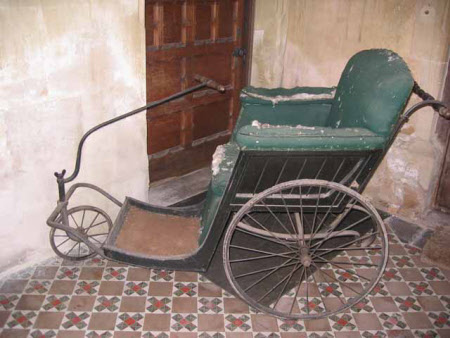Bath chair
Category
Carriages & other vehicles
Date
1875 - 1899
Materials
Painted wood body with cloth lined interior and three rubber shod wheels.
Measurements
108 x 73.5 x 170 cm (3ft 6 1/2in x 2ft 5in x 5ft 7in)
Order this imageCollection
Tyntesfield, North Somerset
NT 10542
Caption
The bath chair was devised by James Heath of Bath, in about 1750 as a discreet mode of transport for ladies and invalids. It rivalled the sedan chair and ultimately superseded it as a form of conveyance. It was steered by the occupant with an attendant on foot pushing from behind. This Bath Chair was built by John Ward of London in the late nineteenth century. John Ward was a renouned builder of such chairs. Upholstered in green baize and painted in black this bath chair would have enabled its occupant to take some air in comfort.
Summary
Bath Chair built in the late nineteenth century by John Ward of London. Bath chair (three wheels) steered by the occupant and propelled by an attendant. The body is of an angular profile and is sprung on sungle leaf elliptic springs. This chair has two large side wheels and a smaller front wheel, which is controlled by a metal frame and vertical cross bar with a cylindrical wooden handle, for the sitter's use. At the back, two metal stems rise up from the chair's base to form a further cross-bar with a cylindrical wooden fitting, to allow controlled movement from the reverse. Upholstered in green cloth and painted in black.
Full description
This Bath Chair was built by John Ward of London in the late nineteenth century. John Ward was a renouned builder of such chairs. Upholstered in green baize and painted in black this bath chair would have enabled its occupant to take some air in comfort. The bath chair was devised by James Heath of Bath, in about 1750 as a discreet mode of transport for ladies and invalids. It rivalled the sedan chair and ultimately superseded it as a form of conveyance. It was steered by the occupant with an attendant on foot pushing from behind.
Provenance
Purchased from the estate of the late Lord Wraxall with the assistance of the NHMF and donations from members and supporters.
Marks and inscriptions
On a small brass plaque on the back of the seat.: John Ward Ltd, 246/7
